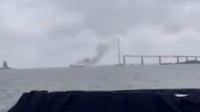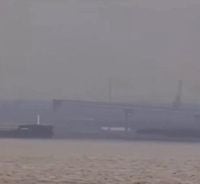On the evening of August 18, 2025, an enormous explosion and subsequent fire aboard a cargo ship near Baltimore’s Francis Scott Key Bridge sent shockwaves through the city and reignited urgent questions about maritime safety, port preparedness, and the lingering scars of a previous disaster. While no lives were lost this time, the incident has drawn national attention and left local residents and officials rattled—especially given the site’s tragic recent history.
According to the Maryland Department of Emergency Management, the explosion occurred at approximately 6:28 p.m. in Baltimore Harbor, just off the Patapsco River, not far from where the Key Bridge collapsed in March 2024. The vessel involved, identified by multiple sources including FOX 5 DC and gCaptain, was the MV W Sapphire, a 751-foot, Liberian-flagged bulk carrier that had just loaded coal at CSX’s Curtis Bay terminal and was beginning its journey to Mauritius.
“We heard a huge explosion,” recounted eyewitness Jay Steinmetz, who was sailing nearby at the time. “I thought that they were blowing up part of the bridge, but obviously I could see after I turned my head that there was a 200-foot plume of smoke over the boat that we’d just seen.” Steinmetz’s account, shared with FOX 5 DC, echoed the shock felt by many in the area. Some residents reported that the blast was so powerful it shook their homes. Noah Bennet, a local, told BNO News, “It shook my whole house.”
Videos of the explosion quickly flooded social media, showing a fireball erupting from the ship’s forward hold and thick black smoke billowing across the Chesapeake Bay. The dramatic footage, captured by both bystanders and harbor cameras, prompted immediate concern about hazardous materials and the safety of those on board and nearby.
Emergency crews responded within minutes. The Baltimore City Fire Department deployed units by both land and water, including the 87-foot John R. Frazier fireboat, while the U.S. Coast Guard and local tugboats assisted in stabilizing the vessel and escorting it off Fort Howard to a designated anchorage. According to officials, all 23 crew members were accounted for and unharmed, and no injuries or property damage beyond the ship itself were reported. “I believe that everybody was fine, and they were able to rescue everybody,” Steinmetz added, having listened to emergency radio traffic from his sailboat.
Authorities quickly evacuated nearby docks and warehouses as a precaution, and the Baltimore Harbor’s main shipping channel was closed temporarily while the situation was brought under control. The fire, which originated below deck, was fully contained by late evening, but not before multiple secondary blasts were reported by witnesses. The cause of the initial explosion remains under investigation, with federal investigators expected to join local authorities to determine whether mechanical failure, human error, or the volatile nature of the cargo played a role.
Coal, the cargo in question, has a long and deadly history at sea. As gCaptain and maritime expert Sal Mercogliano explained, coal is notorious for its risks—spontaneous heating, combustion through oxidation, methane gas explosions, and coal dust ignition. These dangers have plagued shipping for centuries, with countless vessels lost to similar incidents. Modern regulations, like the IMSBC Code, require strict monitoring of coal cargoes for self-heating, methane buildup, and liquefaction risks. Petar Modev, Head of Ship Inspections for the UK P&I Club, warned last year, “The Club is aware of a number of incidents, involving coal cargoes from the East coast of the USA, which were emitting dangerously high levels of methane. On occasions, the ship’s holds natural ventilation was not sufficient to remove the excessive methane concentrations.”
Despite these warnings and the lessons of history, disasters continue to occur—often with devastating consequences. While the crew of the W Sapphire escaped unharmed this time, the explosion has reignited debate about whether enough is being done to ensure maritime safety in Baltimore and beyond.
The incident’s proximity to the Francis Scott Key Bridge collapse only deepens the sense of unease. On March 26, 2024, the container ship Dali lost power and collided with a support pier of the bridge, causing the structure to crumble and killing six construction workers. The port was closed for months, traffic across the region was snarled, and the community was left grieving and frustrated. Federal investigators later found that the Maryland Transportation Authority had failed to conduct a recommended vulnerability assessment that might have identified the bridge’s risk of collapse due to ship strikes.
Efforts to rebuild the Key Bridge are now underway, with officials promising a taller, more resilient cable-stayed design—the first of its kind in the state—estimated to cost over $1.7 billion and potentially opening by 2028. Yet, as gCaptain noted, Baltimore still lacks a Vessel Traffic Service (VTS) system, essentially an air traffic control for ships, despite calls for such a system after last year’s disaster. Seventeen months on, the Coast Guard and NTSB have not scheduled a public hearing to review lessons learned from the bridge collapse, a silence that some experts and community leaders find troubling.
“The real scandal is this: a year and a half after the Dali disaster, Baltimore still lacks a VTS system and the Coast Guard and NTSB have not even scheduled public hearings on what lessons should have been learned,” wrote gCaptain. Without such a hearing, the city’s port may remain vulnerable to similar incidents in the future.
As the investigation into the W Sapphire explosion continues, city officials, maritime authorities, and the public are left to grapple with a host of unanswered questions. How did a modern, regulated vessel carrying a known hazardous cargo suffer such a catastrophic event? Are Baltimore’s emergency response systems and port infrastructure truly up to the task of preventing and managing maritime disasters? And, perhaps most pressing, what will it take for the lessons of the past to finally be heeded?
For now, the W Sapphire remains anchored under the watchful eyes of the Coast Guard, its hull scarred but intact—a stark reminder of both the dangers that linger in global trade and the resilience of the crews who face them. The city, still haunted by the tragedy of the Key Bridge, must once again examine its readiness and resolve to safeguard its harbor and its people.


